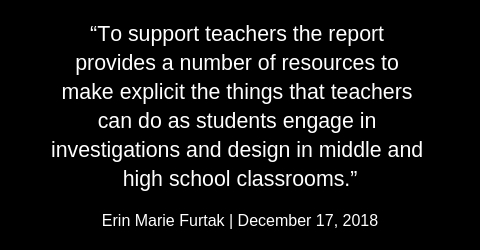What Role Does the Teacher Play in Guiding Investigation and Design?
By Kate Falk
Posted on 2018-12-17

As a member of the committee charged with revising America’s Lab Report, I’ve often been asked the question, why are we updating recommendations now? The reason is simple: we know a lot more now about how students learn science and engineering, and how teachers can support students as they engage in science investigations and engineering design. As the committee wrote the report, we kept in mind the need to provide resources and information for teachers about how to guide and support their students.
Other NSTA blogs have already summarized the shifts in the roles of the students and teachers when investigation and design are at the center of student learning of science and engineering. The report builds on new research that shows that when we start with compelling questions that grow out of students’ everyday experiences, students actually learn more deeply, and in ways that they don’t when we focus on just concepts alone that are not connected to their everyday lives.
This is a dramatic shift in what science classrooms look like. Previously, science learning was often linear, with science laboratories placed in sequences of instruction that included lectures, discussions in which teachers asked initiating questions, students responded, and teachers evaluated those responses (also called IRE discussions), reading textbooks, and taking tests.
In the report, and based on this new research, we rethink and reposition student and teacher activity so that activities are all organized around and supporting the investigations and design. Kids are asking the questions, participating in sensemaking discussions, and engaging in arguments, among other activities (see Figure 4-1 from the report).
We know from research that these kinds of learning experiences are most effective when students are provided with thoughtful guidance and facilitation from their science teachers. These learning environments are not simply ‘hands-on,’ but go much farther. They involve the careful and mindful guidance of the teacher to help students make meaning of the evidence they are collecting in class, to share and argue their ideas, and to revise those ideas as they learn.
To support teachers as they learn to support students in this way, the report provides a number of resources to make explicit the things that teachers can do as students engage in investigations and design in middle and high school classrooms. Chapter 5 is entitled “How Teachers Support Investigation and Design,” and includes rich descriptions of what teachers can do to guide and support students as they make sense of phenomena, gather and analyze data and information, construct explanations and design solutions, communicate reasoning to self and others, and connect learning through multiple contexts. These are summarized in a helpful infographic prepared as part of the report’s release.
Multiple research studies have also examined how teachers use what have been called ‘Talk Moves’ as they interact with students one-on-one, in small groups, and in whole-class discussions throughout the different kinds of activities shown in Figure 4-1. These talk moves serve a number of purposes, from drawing out student ideas, to marking those ideas’ importance, to linking student contributions and building on students’ prior knowledge. These questions are all open-ended and designed to truly draw out and push student thinking in ways that research has shown to be generative and supportive of developing students’ science ideas as they engage in science investigation and engineering design. The report includes a helpful table that summarizes these kinds of talk moves (see Table 5-2).
Several vignettes from the classroom of Bethany, a high school Chemistry teacher, are also sprinkled throughout the report. Bethany starts off a new sequence of investigations by introducing the phenomenon of an oil tanker that crushes after it’s been steam-cleaned and sealed, and the video of this lesson shows 11th graders exclaiming, “Whoa!’ “Holy smokes!” “Why’d that happen?” Bethany wisely responds, before leading students into a multiple-day investigation in which they ultimately learn about the ideal gas law: “That’s a good question, that’s what we’re trying to figure out.” Bethany then asks her students to draw initial models that help to elicit students’ first ideas about what might be happening so that she and the students in class can interact with and build on those ideas, and Bethany and the students return to and revise those models multiple times as they complete a series of investigations to better understand this phenomenon (see Figure 5-1 from the report).
If you’d like to see Bethany and her students in action, the Ambitious Science Teaching website includes videos not only of this lesson, but of Bethany guiding her students through a sequence of learning experiences in which she unpacks students’ initial questions and models about what might be happening with the oil tanker. Teachers might use Figure 4-1 to rethink the way learning experiences are organized in their classrooms, or watch videos of Bethany (or other teachers) while using the ‘talk moves’ table or infographic as resources to track exactly how she guides students in their learning. It is our intention that these resources embedded throughout the report will provide new and helpful supports as teachers learn to guide their students as they engage in science investigation and engineering design.

Erin Marie Furtak is professor of science education and associate dean of faculty in the school of education at the University of Colorado Boulder. Previously,she was a public high school biology and earth science teacher. She is a member of the Committee on Science Investigations and Engineering Design Experiences in Grades 6-12.
Disclaimer: The views expressed in this blog post are those of the author(s) and do not necessarily reflect the official position of the National Science Teaching Association (NSTA).

